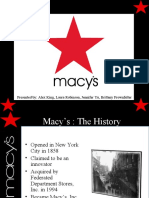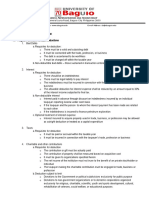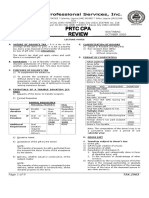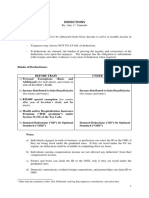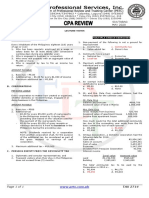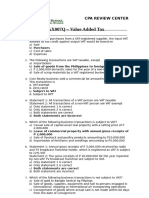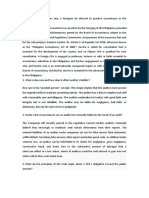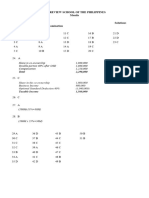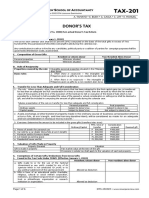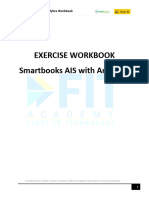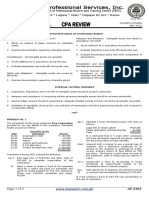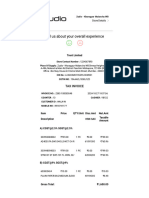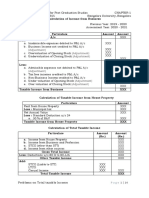TAX-303 (Input Taxes)
TAX-303 (Input Taxes)
Uploaded by
Princess ManaloCopyright:
Available Formats
TAX-303 (Input Taxes)
TAX-303 (Input Taxes)
Uploaded by
Princess ManaloCopyright
Available Formats
Share this document
Did you find this document useful?
Is this content inappropriate?
Copyright:
Available Formats
TAX-303 (Input Taxes)
TAX-303 (Input Taxes)
Uploaded by
Princess ManaloCopyright:
Available Formats
ReSA - THE REVIEW SCHOOL OF ACCOUNTANCY
CPA Review Batch 44 October 2022 CPA Licensure Examination
TAX-303
TAXATION A. TAMAYO E. BUEN G. CAIGA C. LIM K. MANUEL
INPUT TAXES
1. Input Tax Defined
a. Meaning of input Input tax is the value-added tax due from or paid by a VAT-registered person in the course of his
tax trade or business on importation of goods or local purchase of goods, properties or services,
including lease or use of properties, in the course of his trade or business. It shall also include the
transitional input tax and the presumptive input tax.
b. Categories of 1) VAT paid on local purchases (passed on by seller) or on importation (passed-on VAT)
creditable or 2) Presumptive input tax
deductible input 3) Transitional input tax
taxes 4) Standard input tax
c. Persons who can The input tax credit on importation of goods or local purchases of goods, properties or services by a
avail of input tax VAT-registered person shall be creditable:
credit 1) to the importer upon payment of VAT prior to the release of goods from customs custody;
2) to the purchaser of the domestic goods or properties upon consummation of the sale; or
3) to the purchaser of services or the lessee or licensee upon payment of the compensation, rental,
royalty or fee.
d. Exercises: Determine whether or not input tax credit can be availed of (Y/N)
1) Importation of goods for personal use, VAT already paid
2) Importation of goods for business use, VAT not yet paid
3) Purchase on account of domestic goods from VAT-registered supplier evidenced by VAT invoice
4) Purchase for cash of domestic goods from VAT-registered supplier, evidenced by a receipt printed by
unaccredited printer
5) Purchase of domestic properties from non-VAT seller, evidenced by VAT official receipt
6) Purchase of services from a VAT-registered service-provider, bills already paid
7) Purchase of services from a VAT-registered service provider, bills not yet paid
8) Purchase on account of goods from a non-VAT seller who issued VAT invoice
2. Determination of Allowable Input Taxes
a. Determination of Input tax carried over from previous period xxx
creditable input Input tax deferred on capital goods exceeding P1,000,000 from previous quarter xxx
tax Transitional input tax xxx
Presumptive input tax xxx
Others xxx
Total xxx
Input taxes on current transactions xxx
Total available input taxes xxx
Less: Deductions from input taxes xxx
Total allowable input taxes xxx
b. Deductions from a. Input tax claimed as tax credit certificate or refund
input taxes b. Input tax attributed to VAT-exempt sales
c. Input tax attributed to sales to Government
3. Sources of Creditable Input Taxes (Local Purchases or Importation)
a. Passed-on VAT
1) Input tax 1) Purchase or importation of goods:
evidenced by a) For sale; or
a VAT invoice or b) For conversion into or intended to form part of a finished product for sale, including packaging
official receipts materials; or
issued by a VAT- c) For use as supplies in the course of trade or business;
registered d) For use as raw materials supplied in the sale of services;
person which e) For use in trade or business for which deduction for depreciation or amortization is allowed.
shall be valid for 2) Purchase of real properties for which a VAT has actually been paid;
5 years from the 3) Purchase of services in which a VAT has actually been paid;
date of permit 4) Transactions “deemed sale”;
to use
2) VAT-registered A VAT-registered person who is also engaged in transactions not subject to VAT shall be allowed to
person is also recognize input tax credit on transactions subject to VAT as follows:
engaged in a) All the input taxes that can be directly attributed to transactions subject to VAT may be
transactions not recognized for input tax credit; and
subject to VAT
b) If any input tax cannot be directly attributed to either a VAT taxable or VAT-exempt transaction,
the input tax shall be pro-rated to the VAT taxable and VAT-exempt transactions and only the
ratable portion pertaining to transactions subject to VAT may be recognized for input tax credit
computed as follows:
(VAT sales / Total sales) x Input Taxes
Page 1 of 7 0915-2303213 www.resacpareview.com
ReSA – THE REVIEW SCHOOL OF ACCOUNTANCY
INPUT TAXES TAX-303
3) Exercise: A VAT-registered taxpayer is also engaged in VAT-exempt transactions. The following VAT exclusive data are
made available:
a. Domestic VAT-subject cash sales P1,000,000
b. VAT-exempt sales on account 500,000
c. Export cash sales 300,000
d. Cash purchases of supplies from VAT supplier (used for all transactions) 150,000
e. Purchase on account of merchandise from VAT-registered trader (for VAT sales only) 200,000
REQ: a. Prepare the necessary journal entries assuming the taxpayer will use the input tax on zero-rated sales as input tax
credit
b. Compute the VAT payable assuming the taxpayer will use the input tax on zero-rated sales as input tax credit
4) Claim for Input Tax on Depreciable Goods (Under RR 16-2005)
a) Where a VAT-registered a) Estimated useful life is 5 years or more - Input tax shall be spread evenly over
person purchases or imports of a period of 60 months to commence in the calendar month when the capital good
capital goods, which are is acquired.
depreciable assets for
income tax purposes, the b) Estimated useful life is less than 5 years – Input tax shall be spread evenly on
aggregate acquisition of a monthly basis by dividing the input tax by the actual number of months comprising
which (exclusive of VAT) in a the estimated useful life. The claim for input tax shall commence in the calendar
calendar month exceeds month the capital good is acquired
P1,000,000, regardless of the
acquisition cost of each
capital good
b) Where the aggregate The total amount of input taxes will be allowable as credit against output tax in the
acquisition cost (exclusive of month of acquisition.
VAT) of the existing or
finished depreciable capital
goods purchased or imported
during any calendar month
does not exceed P1,000,000
c) Amortization allowed until The amortization of the input VAT shall only be allowed until December 31, 2021 after
December 31, 2021 which taxpayers with unutilized input VAT on capital goods purchased or imported shall
be allowed to apply the same as scheduled until fully utilized.
In the case of purchase of services, lease or use of properties, the input tax shall be
creditable to the purchaser, lessee or licensee upon payment of the compensation, rental,
royalty or fee.
d) Meaning of aggregate The aggregate acquisition cost of a depreciable asset in any calendar month refers to
acquisition cost the total price, excluding the VAT, agreed upon for one or more assets acquired and not
on the payments actually made during the calendar month. An asset acquired in
installment for an acquisition cost of more than P1,000,000, excluding the VAT, will be
subject to the amortization of input tax despite the fact that the monthly payments or
installments may not exceed P1,000,000.
e) Sale or transfer of If the depreciable capital good is sold or transferred within a period of 5 years or prior
depreciable good within a to the exhaustion of the amortizable input tax thereon, the entire unamortized input tax
period of 5 years or prior to on the capital goods sold or transferred can be claimed as input tax credit during the
the exhaustion of the month or quarter when sale or transfer was made.
amortizable input tax
f) Meaning of capital goods or Capital goods or properties refers to goods or properties with estimated useful life
properties greater than one (1) year and which are treated as depreciable assets under the Tax
Code, used directly or indirectly in the production or sale of taxable goods or services.
g) Meaning of construction in Construction in progress (CIP) is the cost of construction work which is not yet
progress completed. CIP is not depreciated until the asset is placed in service. Normally, upon
completion, a CIP is reclassified and the reclassified asset is capitalized and depreciated.
h) Input tax on construction in a) CIP is considered, for purposes of claiming input tax, as a purchase of service, the
progress value of which shall be determined based on the progress billings.
b) Until such time the construction has been completed, it will not qualify as capital
goods as defined, in which case, input tax credit on such transaction can be
recognized in the month the payment was made; Provided, that an official receipt of
payment has been issued based on the progress billings.
i) Contract for the sale of In case of contract for the sale of service where only the labor will be supplied by the
service where only the labor contractor and materials will be purchased by the contractee from other suppliers, input
will be supplied tax credit on the labor contracted shall still be recognized on the month the payment
was made based on the progress billings while input tax on the purchase of materials
shall be recognized at the time the materials were purchased.
j) Input tax claimed while the Once the input tax has already been claimed while the construction is in progress, no
construction is in progress additional input tax can be claimed upon completion of the asset when it has been
reclassified as a depreciable capital asset and depreciated.
k) Rules on allowing input tax a. Only one vehicle for land transport is allowed for the use of an official or employee,
credit on vehicles, and the value of which should not exceed P2,400,000.
other expenses incurred (RR
No. 12-2012, Oct. 12, 2012)
Page 2 of 7 0915-2303213 www.resacpareview.com
ReSA – THE REVIEW SCHOOL OF ACCOUNTANCY
INPUT TAXES TAX-303
b. No depreciation shall be allowed for yachts, helicopters, airplanes and/or aircrafts,
and land vehicles the value of which exceed the P2,400,000 threshold amount,
unless the taxpayer’s main line of business is transport operations or lease of
transportation equipment and the vehicles purchased are used in said operations;
c. All maintenance expenses on account of non-depreciable vehicles for taxation
purposes are disallowed in its entirety;
d. The input taxes on the purchase of non-depreciable vehicles and all input taxes on
maintenance expenses incurred thereon are likewise disallowed for taxation
purposes.
l) Exercises:
1) A taxpayer purchases an office equipment valued at P8,500,000 on January 2018. Its useful life is 6 years.
Question 1 – Can the taxpayer amortize the input tax?
2 – If he can amortize the input tax, how much is the monthly amortization?
3 – Up to what month will the amortization be?
4 – Assuming, he buys the office equipment in January 2022, can he amortize the input tax on the acquisition?
2) Jean Corp. acquires 3 units of office equipment at P600,000 each on February 2018. The estimated life is 4 years.
Question 1 – Can the taxpayer amortize the input tax?
2 – If it can amortize the input tax, how much is the monthly amortization?
3 – Up to what month will the amortization be?
4 – Assuming tbe taxpayer acquires the office equipment on February 2022, can it amortize the input tax on
the acquisition?
3) A taxpayer imports motor vehicle for land transport on December, 2021. Its total landed cost is P2,400,000. The
estimated life of the vehicle is 5 years?
Question 1 – Can the taxpayer amortize the input tax?
2 – If he can amortize the input tax, how much is the monthly amortization?
3 – Up to what month will the amortization be?
4 – Assuming, he imports the vehicle on December 2022, can he amortize the input tax on the importation?
4) A taxpayer aquires an office furniture on January 2018 for P1,000,000. Its estimated life is 3 years.
Question 1 – Can the taxpayer amortize the input tax?
2 – If he can amortize the input tax, how much is the monthly amortization?
b. Presumptive Input Tax
1) Persons allowed presumptive 1) Processors of sardines, mackerel and milk
input tax 2) Manufacturers of refined sugar and cooking oil
3) Manufacturers of packed noodle-based instant meals
2) Rate and basis of presumptive 4% (used to be 1 ½%) of gross value in money of purchases of primary agricultural products
input tax which are used as inputs to their production
3) Exercises: Determine whether or not the following can avail of the presumptive input tax (Y/N)
a) Processor of sardines on its purchase of tomatoes, onions and other agricultural products used as inputs in the
production
b) Processor of sardines on its purchase of fresh fish to be used in the production of processed sardines
c) Processor of fruits on its purchase of fresh fruits to be used in processing canned fruits
d) Manufacturer of refined sugar on its purchase of packaging materials and labels
e) Manufacturer of cooking oil on its purchase of copra
f) Manufacturer of instant champorado on its purchase of glutinous rice to be used in manufacturing instant
champorado
c. Transitional Input Tax
1) Situations where transitional 1) Taxpayers who became VAT-registered persons upon exceeding the minimum turnover of
input tax may be allowed P3,000,000 (used to be P1,919,500) in any 12-month period;
2) Taxpayers who voluntarily register even if their turnover does not exceed P3,000,000
(used to be P1,919,500) (except franchise grantee of radio and/or television broadcasting
whose threshold is P10,000,000);
2) Basis of transitional input tax Beginning inventory of goods, materials and supplies (including those that are VAT-exempt
under Sec. 109)
3) Amount of transitional input 2% (used to be 8%) of the value of the beginning inventory on hand or actual VAT paid on
tax such goods, materials and supplies, whichever is higher.
The value allowed for income tax purposes on inventories shall be the basis for the
computation of the 2% (used to be 8%) transitional input tax, including goods that are
exempt from VAT under Sec. 109 of the Tax Code.
Page 3 of 7 0915-2303213 www.resacpareview.com
ReSA – THE REVIEW SCHOOL OF ACCOUNTANCY
INPUT TAXES TAX-303
4) Exercise: Determine whether or not the following is allowed to claim transitional input tax (Y/N)
a) A trader is engaged in VAT-subject transactions, his gross annual sales do not exceed the VAT threshold amount
b) Service provider is engaged in VAT-subject transactions, his gross annual receipts amount to P3,000,000 but
voluntarily registers under the VAT system
c) Taxpayer is engaged in VAT-subject transactions, his gross annual sales exceed the VAT threshold amount during the
year and decides to register under the VAT system
d) Taxpayer is engaged in VAT-subject transactions, his gross annual receipts exceed the VAT threshold amount during
the year but refuses to register under the VAT system
e) Taxpayer is engaged in VAT-subject transactions who starts a business which he registers under the VAT system
f) A taxpayer is engaged in VAT-subject transactions but enjoys exemption from VAT as an entitty because his annual gross sales do
not exceed the VAT threshold amount. Beginning the current year, he decides to optionally register under the VAT system.
Compute the transitional input tax based on the following data:
Ending inventory VAT-subject goods, previous year
Cost P 250,000
Net realizable value 200,000
Ending inventory VAT-exempt goods, previous year
Cost 1,400,000
Net realizable value 1,450,000
Actual VAT paid on the inventory 30,000
d. Standard Input Tax
1) Input tax attributable to VAT Input taxes that can be directly attributable to VAT taxable sales of goods and services to the
sales to Government not Government or any of its political subdivisions, instrumentalities or agencies including GOCCs
creditable against output tax shall not be credited against output taxes arising from sales to non-Government entities.
on sales to non-Government
entities
2) Government required to The government or any of its political subdivisions, instrumentalities or agencies, including
withhold GOCCs shall deduct and withhold a final VAT due at the rate of five percent (5%) of the gross
payment.
Beginning January 1, 2021, the VAT witholding system under this Subsection shall shift
from final to a creditable system.
The payor or person in control of the payment shall be considered as the withholding
agent.
3) Final withholding VAT The five percent (5%) final withholding VAT rate shall represent the net VAT payable of the
represents the net VAT seller.
payable of the seller
4) Difference between the VAT The remaining seven percent (7%) effectively accounts for the standard input VAT for sales
rate and the withholding VAT of goods or services to government or any of its political subdivisions, instrumentalities or
rate accounts for the standard agencies including GOCCs, in lieu of the actual input VAT directly attributable or ratably
input tax apportioned to such sales.
Should actual input VAT attributable to sale to government exceeds seven percent (7%) of
gross payments, the excess may form part of the seller’s expense or cost. On the other
hand, if actual input VAT attributable to sale to government is less than seven percent (7%)
of gross payment, the difference must be closed to expense or cost.
5) Exercise: A VAT-registered service provider has the following transations for the first quarter of 2018:
1) Purchased materials on account for use in a contract with the Government paying P896,000, gross of VAT.
2) Sent a bill to client with VAT inclusive amount of P5,600,000.
3) Collected P2,000,000 out of the P5,000,000 contract price, net of 5% withholding VAT and 2% withholding income tax.
Prepare the necessary journal entries on the books of the service provider.
e. Withholding VAT
Transactions Withholding Agent Withholdng VAT Rate
1) Purchase of goods by Government or any of its political subdivisions, instrumentalities 5% (used to be 3%) of
Government, political or agencies, including government-owned or controlled gross payment made
subdivisions, etc. corporations (GOCCs) (final)
2) Purchase of services by Government or any of its political subdivisions, instrumentalities 5% (used to be 6%) of
Government, political or agencies, including government-owned or controlled gross payments (final)
subdivisions, etc. corporations (GOCCs)
3) Payments for lease or use of Government or any of its political subdivisions, instrumentalies or 12%
properties or property rights agencies, including GOCC’s;
to non-resident owners
Private corporations, individuals, estate and trusts, whether large
or non-large taxpayers
Payor or person in control of the payment
4) Purchase of goods or Payor-purchaser in the course of trade of business 12% of payee’s gross
services in the course of trade sales or receipts
or business (payee-seller has Payee-seller shall execute:
more than one payor-buyer) 1) “Waiver of the Privilege to Claim Input Tax Credit”, and
2) “Notice of Availment of the Option to Pay the Tax through the
Withholding Process”.
Page 4 of 7 0915-2303213 www.resacpareview.com
ReSA – THE REVIEW SCHOOL OF ACCOUNTANCY
INPUT TAXES TAX-303
5) Purchase of goods or Payor-purchaser in the course of trade of business 12% of payee’s gross
services in the course of trade sales or receipts
or business (payee-seller has Payee-seller shall execute waiver and notice of availment as in
only one payor-buyer for the above.
whole year)
6) Payments for purchases of None Not subject to
goods and services arising withholding tax
from projects funded by
Official Development
Assistance (ODA) as defined
under Republic Act No.
8182, otherwise knownas
the‘OfficialDevelopment
AssistanceAct of 1996’, as
amended
6) Exercise: A VAT-registered trader has waived his privilege to claim input tax credit and filed a notice availment of the option to
pay the tax through the withholding process. He sells P1,000,000 worth of goods to a person who buys in the course of business.
During the same period, he purchases from a supplier P500,000 worth of goods. All of the of transactions are net of VAT.
Determine the following:
a. withholding VAT
b. entry in the books of the seller (payee) in connection with the sale to a person who buys in the course of trade or business
c. entry in the books of the payee in connection with the purcahse of supplies
d. entry in the books of the person (payor) who buys in the course of trade or business
e. entry in the books of the buyer (payor) when the withholding tax is remitted to the BIR
f. VAT payable of the seller (payee)
f. VAT-registered who opted to register as non-VAT as a result of additonal VAT-exempt provisions
1) Requirements A VAT-registered taxpayer who opted to register as non-VAT as a result of the additional VAT-
exempt provisions under Sections 109(1)(R), 109(1)(AA), and 109(1)(BB) of the Tax Code, as
amended by CREATE Act and provided that it did not meet the threshold set under Section
109(1)(CC) thereof, shall:
a. Submit an inventory list of unused invoices and/or receipts as of the date of filing
of application for update of registration from VAT to Non-VAT, indicating the
number of booklets and its corresponding serial numbers; and
b. Surrender the said invoices and/or receipts for cancellation.
2) Unused invoices or A number of unused invoices/receipts, as determined by the taxpayer with the approval of the
receipts appropriate BIR Office, may be allowed for use, provided the phrase “Non VAT registered as of
(date of filing an application for update of registration) Not valid for claim of input tax.” shall
be stamped on the face of every copy thereof, until new registered non-VAT invoices or
receipts have been received by the taxpayer or until August 31, 2021.
3) Submission of new Upon receipt of newly-printed registered non-VAT invoices or receipts, the taxpayer shall
inventory list of
submit immediately a new inventory list of, and surrender for cancellation, all unused
unused previoiusly-
stamped invoices or previously-stamped invoices/receipts.
receipts
4) Treatment of the The taxpayer shall treat the resulting excess taxes paid due to the inclusion in the items
resulting excess taxes exempt from VAT or adjustment in Percentage Tax rates, as the case may be, in the following
paid due to VAT-
manner:
exemption
a) Unutilized VAT paid on local purchases and importation under subsections 4.109
1(B)(aa)(ii) and 4.109-1(B)(bb) hereof from their specified effectivity under RA No. 11534
on January 1, 2021 until the effectivity of these Regulations may be carried over to the
succeeding taxable quarter/s or be charged as part of cost, pursuant to Section 110 of the
Tax Code.
b) Input VAT, which are directly attributable to goods now classified as VAT- exempt, may be
allowed as part of cost. For input VAT that cannot be attributed to goods now classified as
VAT-exempt, only a ratable portion thereof shall be charged to cost.
Page 5 of 7 0915-2303213 www.resacpareview.com
ReSA – THE REVIEW SCHOOL OF ACCOUNTANCY
INPUT TAXES TAX-303
5) Exercises:
a) SR Pharmaceutical Corporation is an exclusive disctirbutor of certan brand of prescription drugs for cancer and serveral drugs in
the Philippines. For the period January to March 2021, the said company had the followng:
Inventory of cancer drugs as of December 31, 2020 P200,000,000.00
Sale of cancer medicine (goods from previous inventory) 200,000,000.00
Total sales for the period 500,000,000.00
Percentage of sale of cancer medicines to total sales for the period 40%
All input taxes from the existng inventory of cancer drugs have been utilized as of December 31, 2020.
SR Pharmaceutical Corporation incurred P20,000,000.00 of input tax for the period from purchases of medicine other than
those prescribed for cancer and no additonal purchases of prescription drugs for cancer was purchased during the period.
Compute the VAT payable
b) AJ Pharmaceutical Corporation incurred P20,000,000.00 of input tax for the period from purchases of medicines other than
those prescribed for cancer and no additional purchases of prescription drugs for cancer was purchased during the period.
There was an unutiized input tax of P10,000,000.00 coming from the inventory of cancer drugs from previous period that was
carried over to the secceeding quarter and 50% of the inventory of cancer drugs was sold during the period.
Compute the VAT payable
c) EF Pharmaceutical Corporation sold drugs for cancer which were part of the corporation’s previous and current purchases.
Total sales for the period is P500,000,000.00, fifty percent (50%) of which is VAT-exempt. The corporation also incurred
P20,000,000.00 of input tax for the period from purchases of medicines including those prescribed for cancer. There was an
unutlized input tax of P10,000,000.00 coming from the previoius period but cannot be attributed to the inventory of drugs
for cancer.
Compute the VAT payable
f. Remittance of withholding VAT
Remittance of The VAT withheld shall be remitted within ten (10) days following the end of the month the
withholding VAT withholding was made.
g. Advance Payment of VAT
Transactions requiring 1) Sale of refined sugar
advance payment of VAT 2) Sale of flour
3) Transport of Naturally Grown and Planted Timber Products (RR No. 13-2007)
4) Sale of jewelry, gold and other metallic minerals (RR No. 5-2013)
Advance payment of VAT The advance payments made by the seller/owner of refined sugar, importer or miller of wheat/flour
allowed as credit against and sellers/ owners of naturally grown and planted timber products shall be allowed as credit against
output tax their output tax on the actual gross selling price of refined sugar/flour/timber products.
Advance payments may Advance payments which remain unutilized at the end of the taxpayer’s taxable year where the
be available for issuance advance payment was made, which is tantamount to excess payment, may, at the option of the
of tax credit certificate owner/seller/taxpayer or importer/miller/taxpayer, be available for the issuance of TCC upon
(TCC) application duly filed with the BIR by the seller/owner or importer/miller within two (2) years from
the date of filing of the 4 th quarter VAT return of the year such advance payments were made, or if
filed out of time, from the last day prescribed by law for filing the return.
Advance VAT payment Advance VAT payments which have been the subject of an application for the issuance of TCC shall
claimed as TCC cannot be not be allowed as carry-over nor credited against the output tax of the succeeding quarter/year.
carried over
Issuance of TCC limited to Issuance of TCC shall be limited to the unutilized advance VAT payment and shall not include excess
unutilized advance VAT input tax.
payment
Separare applications Issuance of TCC for input tax attributable to zero-rated sales shall be covered by a separate
required application for TCC following the applicable rules.
4. Refund of Input Tax
a. Input Tax on Zero- A VAT-registered person whose sales of goods, properties or services are zero-rated or effectively
Rated Sales of Goods zero-rated may apply for the issuance of a tax credit certificate or refund of input tax attributable to
or Property, Etc. such sales.The input tax that may be subject of the claim shall exclude the portion of input tax that
has been applied against the output tax. The application should be made within 2 years after the
close of the taxable quarter when the sales were made.
b. Printing of the word The Supreme Court has ruled in several cases that the printing of the word “zero-rated” is required
“zero-rated” required to be placed on the VAT invoices or receipts covering zero-rated sales in order to be entitled to claim
for tax credit or refund.
c. Other documents may In another case, failure of the taxpayer to indicate its zero-rated sales in its VAT returns and in its
be used to prove official receipts is not sufficient reason to deny its claim for tax credit or refund when there are other
“zero-rated” sale documents from which the court can determine the veracity of the taxpayer’s claims. (Southern
Philippine Power Corp. vs. CIR, G.R. 179632, Oct. 19, 2011)
d. Excess or unutilized Excess/Unutilized input taxes as a result of the change of status from VAT to Non- VAT
input taxes as a result registration under Sec. 112(B) of the Tax Code of 1997, as amended, may be subject to
of change of status refund or the issuance of Tax Credit Certificate (TCC), at the option of the taxpayer.
from VAT to Non-VAT
Page 6 of 7 0915-2303213 www.resacpareview.com
ReSA – THE REVIEW SCHOOL OF ACCOUNTANCY
INPUT TAXES TAX-303
e. Unused Input Tax of A VAT-registered person whose registration has been cancelled due to retirement or cessation of
Person Who Retired or business, or due to change in or cessation of status may, within 2 years from the date of
Ceased Business cancellation, apply for the issuance of a tax credit certificate for any unused input tax which he may
use in payment of his other internal revenue taxes. He shall be entitled to a refund if he has no
internal revenue tax liabilities.
f. Period of Refund or Refund or tax credit certificate shall be granted within 90 days starting January 1, 2018
Tax Credit of Input (within 120 days before TRAIN) from the date of submission of the official receipts or invoices
Tax and other documents in support of the application filed.
However, all claims for refund/tax credit certificate filed prior to January 1, 2018 shall still be
governed by the one hundred twenty (120)-day processing period.
Provided, That should the Commissioner find that the grant of refund is not proper, the
Commissioner must state in writing the legal and factual basis for the denial.
g. Appeal of full or partial “In case of full or partial denial of the claim for tax refund, the taxpayer affected may, within
denial thirty (30) days from the receipt of the decision denying the claim, appeal the decision with
the Court of Tax Appeals: Provided, however, That failure on the part of any official, agent, or
employee of the BIR to act on the application within the ninety (90)-day period shall be
punishable under Section 269 of this Code.
h. Manner of Giving Refunds shall be made upon warrants drawn by the Commissioner of Internal Revenue or by
Refunds his authorized representative without the necessity of being countersigned by the COA
Chairman.
5. Caselets
a. Elirie Corporation, VAT-registered, has the following transactions during the month of January, 2021:
Domestic sales, exclusive of VAT P 800,000
Importation of goods for sale 240,000
Importation of goods for personal use 100,000
Purchase of office supplies, exclusive of VAT 20,000
Purchase of office equipment, total invoice price (estimated life is 3 years) 1,680,000
Purchase of home appliances for the residence of Elirie Corp’s President., gross of VAT 17,920
Payment of services for store repair, contractor not VAT- registered but issued VAT officeial receipt
(total invoice amount) 33,600
Purchase of services for repainting of store (evidenced by ordinary receipt issued by contractor) 4,480
Purchase of real property to be used as office, VAT not included, purchase price not paid yet 500,000
Purchase of vehicle for land transport and for business use, net of VAT 1,200,000
Payment of maintenance expenses for vehicle for land transport, net of VAT 50,000
Question 1 – How much of the VAT on importation can be claimed as input tax credit?
2 – How much of the input tax on purchase of office equipment can be claimed as input tax credit?
3 – Can the passed-on VAT on purchase of vehicle for land transport be claimed as input tax credit? Why or why
not?
4 – Can the passed-on VAT by a service contactor who is not VAT registered be claimed as input tax credit?
5 – How much is the total allowable input taxes for the month?
b. F. Yabut, VAT registered taxpayer, has the following data for the first month of the second quarter of 2021:
Domestic sales, net of 12% VAT P5,000,000
Export sales 3,000,000
VAT-exempt sales 2,000,000
Purchases attributed to domestic sales, excluding 12% VAT 500,000
Purchases attributed to export sales, not including 12% VAT 1,500,000
Purchases attributed to exempt sales, net of 12% VAT 1,000,000
Purchases attributed to all sales, net of 12% VAT 800,000
Question 1 – How much of the total input taxes can be claimed as tax credit certificate or tax refund?
2 – How much of the total input taxes can claimed as input tax credit against the output tax on domestic sales?
3 – Assuming the taxpayer decides to apply a portion of the input taxes attributable to zero-rated sales against
the output tax, what is the net amount of input tax that can be claimed as tax credit certificate or tax refund?
4 – How much of the total input tax will be charged to cost or expense?
END
“Do not settle for just being good, be the best you can be.” – Tamthewise
Page 7 of 7 0915-2303213 www.resacpareview.com
You might also like
- The Evolution of Economic Ideas and Systems PDFDocument207 pagesThe Evolution of Economic Ideas and Systems PDFFrancis Gabriel Abog100% (1)
- BA 121 Case 1 - WhodunitDocument1 pageBA 121 Case 1 - WhodunitalheruelaNo ratings yet
- Macy's Retail Analysis PresentationDocument22 pagesMacy's Retail Analysis PresentationBrittany E. Frownfelter100% (1)
- TAX-303 (Input VAT)Document8 pagesTAX-303 (Input VAT)Fella GultianoNo ratings yet
- TAX-401 (Other Percentage Taxes - Part 1)Document5 pagesTAX-401 (Other Percentage Taxes - Part 1)Princess ManaloNo ratings yet
- Tax CPAR Final Pre Board2Document5 pagesTax CPAR Final Pre Board2Floyd delMundo100% (1)
- TAX-301 (VAT-Subject Transactions)Document9 pagesTAX-301 (VAT-Subject Transactions)Princess ManaloNo ratings yet
- Items of Gross Income Subject To RegularDocument2 pagesItems of Gross Income Subject To Regularace zeroNo ratings yet
- INTGR TAX 009 DeductionsDocument6 pagesINTGR TAX 009 DeductionsJohn Paul SiodacalNo ratings yet
- Taxation Sia/Tabag TAX.2903-Donor's Tax OCTOBER 2020Document8 pagesTaxation Sia/Tabag TAX.2903-Donor's Tax OCTOBER 2020Bryan Christian MaragragNo ratings yet
- Estate Tax MCQSDocument43 pagesEstate Tax MCQSpdmallari12No ratings yet
- AFAR Preweek B94 - Questionnaire - Answers (Theories)Document13 pagesAFAR Preweek B94 - Questionnaire - Answers (Theories)Silver LilyNo ratings yet
- Jse Module2 Ae25 BTDocument7 pagesJse Module2 Ae25 BTAbeline Martin MestiolaNo ratings yet
- CPAR Deductions (Batch 92) - HandoutDocument30 pagesCPAR Deductions (Batch 92) - HandoutaudreyNo ratings yet
- BLT 2012 First Pre-Board July 28Document14 pagesBLT 2012 First Pre-Board July 28Lester AguinaldoNo ratings yet
- TAX.2814 Community-Taxes AnswersDocument1 pageTAX.2814 Community-Taxes AnswersCams DlunaNo ratings yet
- Percentage Taxes NotesDocument4 pagesPercentage Taxes NotesWearIt Co.No ratings yet
- Quiz 4 6 CompilationDocument8 pagesQuiz 4 6 CompilationShelleyNo ratings yet
- Individual Taxpayers (Tabag2021)Document14 pagesIndividual Taxpayers (Tabag2021)Veel Creed100% (1)
- Module 7 Chapter 9 Input VATDocument7 pagesModule 7 Chapter 9 Input VATChris SumandeNo ratings yet
- Vat Examination Test Bank - CompressDocument8 pagesVat Examination Test Bank - CompressLenson NatividadNo ratings yet
- Tax Quiz 4Document61 pagesTax Quiz 4Seri CrisologoNo ratings yet
- CPAR General Principles (Batch 93) - HandoutDocument12 pagesCPAR General Principles (Batch 93) - HandoutJuan Miguel UngsodNo ratings yet
- CTT Examination Reviewer (Notes) Page A - 30Document13 pagesCTT Examination Reviewer (Notes) Page A - 30Seneca GonzalesNo ratings yet
- Under What Conditions May A Foreigner Be Allowed TDocument3 pagesUnder What Conditions May A Foreigner Be Allowed TANGELU RANE BAGARES INTOLNo ratings yet
- TAX First Preboard B96 - Solutions - 240805 - 093539Document9 pagesTAX First Preboard B96 - Solutions - 240805 - 093539sugammi.7137No ratings yet
- Filling, Penalties and RemediesDocument14 pagesFilling, Penalties and RemediesMichael Brian TorresNo ratings yet
- Estate TaxDocument2 pagesEstate Taxucc second yearNo ratings yet
- Documentary Stamp TaxDocument13 pagesDocumentary Stamp TaxJessNo ratings yet
- Corporate Income Tax RateDocument3 pagesCorporate Income Tax RateJuliana ChengNo ratings yet
- TAX Preweek Lecture (B42) - December 2021 CPALEDocument16 pagesTAX Preweek Lecture (B42) - December 2021 CPALEkdltcalderon102No ratings yet
- Case Number FourDocument2 pagesCase Number FourPatricia Louise Anatalio100% (1)
- LEAD BATCH 2 - ERG-TAX 1 Estate Tax - George James Comprehensive Problem-AnsDocument2 pagesLEAD BATCH 2 - ERG-TAX 1 Estate Tax - George James Comprehensive Problem-AnsJims Leñar CezarNo ratings yet
- TAX-201 (Donor's Tax)Document6 pagesTAX-201 (Donor's Tax)Princess ManaloNo ratings yet
- Mock 2nd Eval - TOADocument7 pagesMock 2nd Eval - TOAPatrick Powell100% (1)
- TX 201Document8 pagesTX 201Lhivanne LamintadNo ratings yet
- Chapter 2 - Donor's Tax (Notes)Document8 pagesChapter 2 - Donor's Tax (Notes)Angela Denisse FranciscoNo ratings yet
- CPAR Sale or Exchange of Property (Batch 93) HandoutDocument7 pagesCPAR Sale or Exchange of Property (Batch 93) HandoutJuan Miguel UngsodNo ratings yet
- Practice Exercises No. 3, 4, and 5Document3 pagesPractice Exercises No. 3, 4, and 5Ei Ar TaradjiNo ratings yet
- Straight Problems Income Tax Bsa2Document2 pagesStraight Problems Income Tax Bsa2dimpy dNo ratings yet
- InTax - Items - of - Gross - Income TAMAYAO - GARCIA RESADocument5 pagesInTax - Items - of - Gross - Income TAMAYAO - GARCIA RESAAbby NavarroNo ratings yet
- Mas Solutions To Problems Solutions 2018Document14 pagesMas Solutions To Problems Solutions 2018Jahanna Martorillas0% (1)
- SPL ReviewerDocument6 pagesSPL Reviewerapril75No ratings yet
- FAR04-12 - Provisions, Contingency and Other Short-Term LiabilitiesDocument8 pagesFAR04-12 - Provisions, Contingency and Other Short-Term LiabilitiesAi NatangcopNo ratings yet
- Taxation - Tax Remedies 02282019Document13 pagesTaxation - Tax Remedies 02282019Jtm PasigNo ratings yet
- Allowable Deductions Part 1Document3 pagesAllowable Deductions Part 1John Rich GamasNo ratings yet
- Sample QuestionsDocument9 pagesSample Questionsrav danoNo ratings yet
- TAX of PinalizeDocument19 pagesTAX of PinalizeDennis IsananNo ratings yet
- Problems 1Document6 pagesProblems 1Russel BarquinNo ratings yet
- 1.1 Forex Key To CorrectionDocument4 pages1.1 Forex Key To Correctionalibanto.sherwinNo ratings yet
- Anti-Money Laundering Act - TestbankDocument2 pagesAnti-Money Laundering Act - TestbankHads LunaNo ratings yet
- Taxation - Fisrt Pre-Board - 2016NDocument11 pagesTaxation - Fisrt Pre-Board - 2016NKenneth Bryan Tegerero Tegio100% (2)
- Accounting Technician Level 3 Module 3 Part 1Document29 pagesAccounting Technician Level 3 Module 3 Part 1Rona Amor MundaNo ratings yet
- 7&8 - Analytics Workbook - v2023-6Document30 pages7&8 - Analytics Workbook - v2023-6Karla Cathrina FernandoNo ratings yet
- TAX - 601 - Individuals - Abapo, Mary Jhudiel G.Document53 pagesTAX - 601 - Individuals - Abapo, Mary Jhudiel G.Mohammad100% (1)
- AP.3403 Audit of Intangible AssetsDocument3 pagesAP.3403 Audit of Intangible AssetsMonica GarciaNo ratings yet
- SCRC 3 CorporationDocument18 pagesSCRC 3 CorporationChristine Yedda Marie AlbaNo ratings yet
- RFBT NotesDocument8 pagesRFBT NotesLuisa Victoria BelmonteNo ratings yet
- National Federation of Junior Philipinne Institute of Accountants - National Capital Region Taxation (Tax)Document10 pagesNational Federation of Junior Philipinne Institute of Accountants - National Capital Region Taxation (Tax)joyceNo ratings yet
- TAX-303 (Input Taxes)Document7 pagesTAX-303 (Input Taxes)Edith DalidaNo ratings yet
- Tax 303 - Input VatDocument7 pagesTax 303 - Input VatiBEAYNo ratings yet
- VAT Input TaxesDocument7 pagesVAT Input TaxesJocelyn Verbo-AyubanNo ratings yet
- TAX-502 (Excise Tax Rates - Part 2)Document3 pagesTAX-502 (Excise Tax Rates - Part 2)Princess ManaloNo ratings yet
- TAX-101 (Estate Tax)Document11 pagesTAX-101 (Estate Tax)Princess ManaloNo ratings yet
- Lit 2 - Midterm Lesson Part 2Document5 pagesLit 2 - Midterm Lesson Part 2Princess ManaloNo ratings yet
- Lit 2 - Midterm Lesson Part 5Document20 pagesLit 2 - Midterm Lesson Part 5Princess ManaloNo ratings yet
- Lit 2 - Midterm Lesson Part 1Document4 pagesLit 2 - Midterm Lesson Part 1Princess ManaloNo ratings yet
- KAZI SailPoint DeveloperDocument5 pagesKAZI SailPoint Developerabhay.rajauriya1No ratings yet
- Your Bill ZudioDocument3 pagesYour Bill Zudio33coursera33No ratings yet
- Empathy & Experience Map For Coffeehouse CustomersDocument4 pagesEmpathy & Experience Map For Coffeehouse CustomersPrince MishraNo ratings yet
- CMC Letter No 12214Document2 pagesCMC Letter No 12214situsatyajeetNo ratings yet
- Six Sigma Case StudiesDocument52 pagesSix Sigma Case StudieseminatoNo ratings yet
- EY S GHG Protocol Disclosure Checklist 1691454645Document26 pagesEY S GHG Protocol Disclosure Checklist 1691454645sujaysarkar85No ratings yet
- Literature Review On Customer Relationship Management in BanksDocument4 pagesLiterature Review On Customer Relationship Management in Banksc5m07hh9No ratings yet
- Advantages & LimitationsDocument3 pagesAdvantages & LimitationsEboni FernandesNo ratings yet
- Top 17 Payroll Interview Questions & Answers: 1) Mention What Is Payroll?Document5 pagesTop 17 Payroll Interview Questions & Answers: 1) Mention What Is Payroll?larryching_884369919100% (1)
- Cold Email: Referral V1Document4 pagesCold Email: Referral V1krishnapal singhNo ratings yet
- Hse Activities & Development Register Plan 2024Document2 pagesHse Activities & Development Register Plan 2024Fariz Fatahillah AlbugisiNo ratings yet
- C-4 Final Cause List 09.02.2023 - 0Document13 pagesC-4 Final Cause List 09.02.2023 - 0Prakhar SinghNo ratings yet
- End Term Fmi MMS 2020Document2 pagesEnd Term Fmi MMS 2020akshu kumarNo ratings yet
- Wage Differentials and Heterogenous JobsDocument12 pagesWage Differentials and Heterogenous JobsTooba JabbarNo ratings yet
- En PERIBOOK 2023 InternationalDocument151 pagesEn PERIBOOK 2023 Internationalespeciencias99No ratings yet
- Approvals Management Engine (AME) Integration With Advanced Global Intercompany SystemsDocument24 pagesApprovals Management Engine (AME) Integration With Advanced Global Intercompany SystemsSiva NagaNo ratings yet
- Chapter 9Document42 pagesChapter 9Gerry AfrNo ratings yet
- Pag Ibig Foreclosed Properties Pubbid102716 NCR With Discount CompressedDocument9 pagesPag Ibig Foreclosed Properties Pubbid102716 NCR With Discount CompressedWilliam Lloyd Cordero100% (1)
- Empanelment Agreement Template - Kritika Nesargi (Draft)Document11 pagesEmpanelment Agreement Template - Kritika Nesargi (Draft)Danika JoplinNo ratings yet
- PDF AVPNDocument10 pagesPDF AVPNpoulomi.pal28No ratings yet
- Application of TOPSIS Method For Decision Making: April 2020Document7 pagesApplication of TOPSIS Method For Decision Making: April 2020Mrinal ManojNo ratings yet
- Herbal CosmeticsDocument3 pagesHerbal Cosmeticsamekheimar19750% (1)
- Service Quality in Maritime Transport: Conceptual Model and Empirical EvidenceDocument26 pagesService Quality in Maritime Transport: Conceptual Model and Empirical EvidenceYenu EthioNo ratings yet
- Biflex Phils. Inc. Labor Union vs. Filflex Industrial and Manufacturing Corp., G.R. No. 155679, 2006Document2 pagesBiflex Phils. Inc. Labor Union vs. Filflex Industrial and Manufacturing Corp., G.R. No. 155679, 2006Rain HofileñaNo ratings yet
- Tugas Bahasa Inggris Tentang 10 SoalDocument10 pagesTugas Bahasa Inggris Tentang 10 SoalGintan Novia WulandariNo ratings yet
- Commercial Agency Private AgreementDocument6 pagesCommercial Agency Private AgreementMenna ElabdeenyNo ratings yet
- Final Investigation 1Document1 pageFinal Investigation 1NBC 10 WJARNo ratings yet
- Chapter 1 Problems HDocument14 pagesChapter 1 Problems Hbalaji RNo ratings yet


